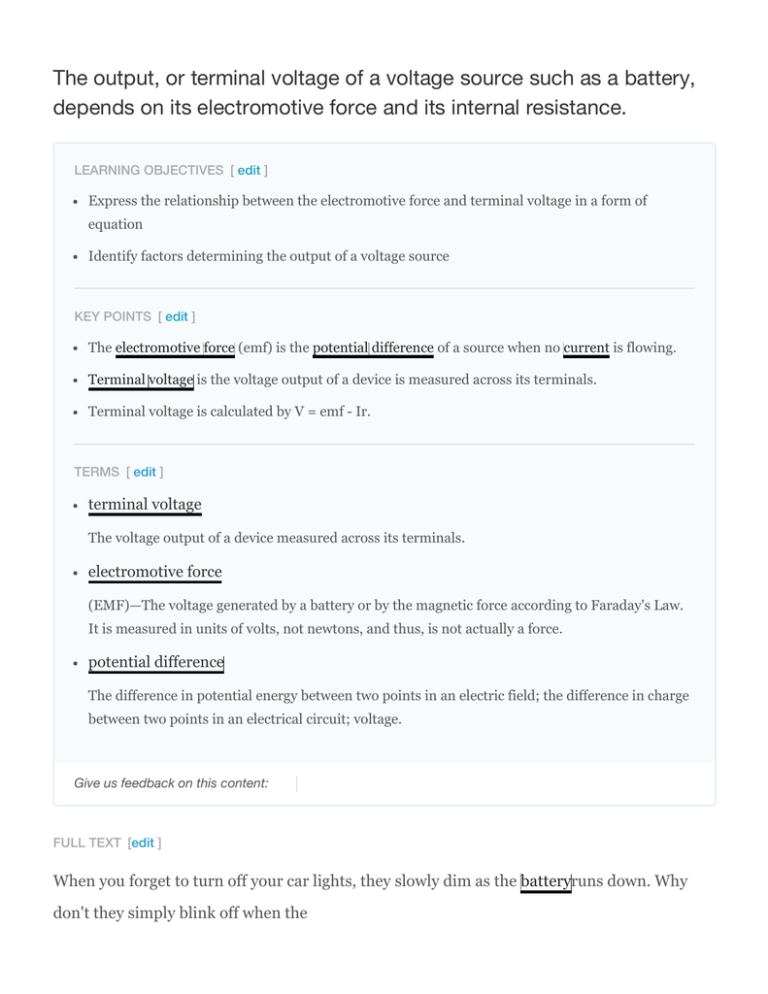The output, or terminal voltage of a voltage source such
advertisement

The output, or terminal voltage of a voltage source such as a battery, depends on its electromotive force and its internal resistance. LEARNING OBJECTIVES [ edit ] Express the relationship between the electromotive force and terminal voltage in a form of equation Identify factors determining the output of a voltage source KEY POINTS [ edit ] The electromotive force (emf) is the potential difference of a source when no current is flowing. Terminal voltage is the voltage output of a device is measured across its terminals. Terminal voltage is calculated by V = emf - Ir. TERMS [ edit ] terminal voltage The voltage output of a device measured across its terminals. electromotive force (EMF)—The voltage generated by a battery or by the magnetic force according to Faraday's Law. It is measured in units of volts, not newtons, and thus, is not actually a force. potential difference The difference in potential energy between two points in an electric field; the difference in charge between two points in an electrical circuit; voltage. Give us feedback on this content: FULL TEXT [edit ] When you forget to turn off your car lights, they slowly dim as the batteryruns down. Why don't they simply blink off when the battery's energy is gone? Their gradual dimming implies that battery output voltage decreases as the battery is depleted. The reason for the decrease in output voltage for depleted or overloaded batteries is that all voltage sources have two fundamental parts—a source of electrical energy and an internal resistance. Electromotive Force Register for FREE to stop seeing ads All voltage sources create a potential difference and can supply current if connected to a resistance. On a small scale, the potential difference creates an electric field that exerts force on charges, causing current. We call this potential difference the electromotive force (abbreviated emf). Emf is not a force at all; it is a special type of potential difference of a source when no current is flowing. Units of emf are volts. Electromotive force is directly related to the source of potential difference, such as the particular combination of chemicals in a battery. However, emf differs from the voltage output of the device when current flows. The voltage across the terminals of a battery, for example, is less than the emf when the battery supplies current, and it declines further as the battery is depleted or loaded down. However, if the device's output voltage can be measured without drawing current, then output voltage will equal emf (even for a very depleted battery). Terminal Voltage presents a schematic representation of a voltage source. The voltage output of a device is measured across its terminals and is called its terminal voltage V. Terminal voltage is given by the equation: Schematic Representation of a Voltage Source Any voltage source (in this case, a carbon­zinc dry cell) has an emf related to its source of potential difference, and an internal resistance r related to its construction. (Note that the script E stands for emf. ) Also shown are the output terminals across which the terminal voltage V is measured. Since V=emf−Ir, terminal voltage equals emf only if there is no current flowing. V = emf − Ir , where r is the internal resistance and I is the current flowing at the time of the measurement. I is positive if current flows away from the positive terminal. The larger the current, the smaller the terminal voltage. Likewise, it is true that the larger the internal resistance, the smaller the terminal voltage.


